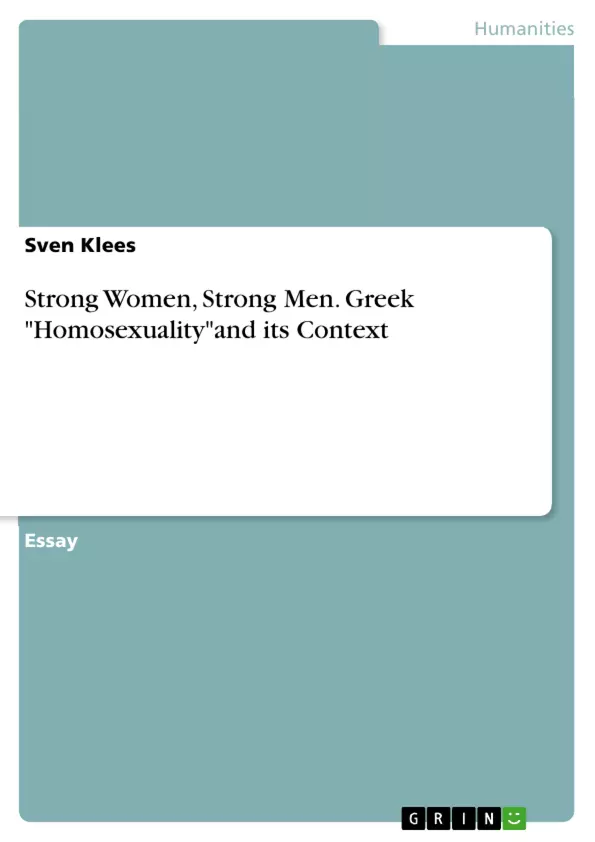This paper aims to offer an explanation for the fact that "homosexuality" as we would label it today, the sexual intercourse between two individuals of the male sex, was condoned – at least in a polis such as Athens – and even developed into some kind of social institution that carried adolescent boys over to manhood.
The most difficult thing about conducting an analysis about the ancient Greek world it that is has been interpreted differently and in contradictory ways by different scholars. It is therefore easy to lose one’s way as the evidence in the form of literary works and visual art (usually vases) is contradictory in itself and does not inform straightforward analysis.
It will be argued that male-male sexual intercourse is a manifestation of Greek polis’ societies’ rigid division into a "domestic" sphere, in which the leading female figure seems to be the dominant figure and a ‘public’ sphere that was almost exclusively reserved for males. In other words, male-male intercourse is the public domain’s equivalent of male-female intercourse in the the domestic sphere.
In a second step, the idea of male-male sexual acts as an in-between stage of boyhood and manhood will be reviewed. This idea has to be accepted as long as there is no strong scientific evidence that contradicts the hypothesis. At least, some objects of visual art are likely to be proof of such a custom.
Lastly, article by Lin Foxhall is analyzed and interpreted that although being less recent, offers an alternative to depicting women as generally inferior to their husband. Rather it suggests the opposite, at least with regard to the "domestic" sphere. This perspective is able to show that the two different spheres can offer an explanation of sexual activity between male and female individuals, that is husband and wife, in the "domestic"sphere, and two males in the "public" sphere.
Inhaltsverzeichnis (Table of Contents)
- Introduction
- The Limits of 'Power': Historical Evidence of Male-Male Sexual Activity
- Slave, Sex Slave, and Suddenly Free? – The Way of Becoming a Man
- Powerful Women
Zielsetzung und Themenschwerpunkte (Objectives and Key Themes)
This paper aims to explain the acceptance and even institutionalization of male-male sexual intercourse in ancient Greece, particularly in Athens. It challenges existing interpretations that emphasize power dynamics and instead proposes an alternative understanding based on societal structures.
- Re-evaluation of existing interpretations of ancient Greek homosexuality
- The role of power dynamics in male-male sexual relationships
- Male-male sexual activity as a rite of passage
- The social structures of the Greek polis and their impact on sexuality
- Challenging traditional views of women's roles in ancient Greece
Zusammenfassung der Kapitel (Chapter Summaries)
Introduction: The introduction discusses the challenges of interpreting ancient Greek sexuality due to conflicting scholarly interpretations and contradictory evidence. It introduces the central argument that male-male sexual intercourse should be understood within the context of the public and domestic spheres of ancient Greek society.
The Limits of 'Power': Historical Evidence of Male-Male Sexual Activity: This chapter challenges the view that male-male sexual relationships in Athens were inherently unequal, using evidence from ancient vase paintings to suggest that power dynamics were not always as straightforward as previously assumed.
(Note: Summaries for Chapters 3 and 4 are omitted to avoid spoilers.)
Schlüsselwörter (Keywords)
Ancient Greek sexuality, male-male sexual intercourse, power dynamics, social structures, public and domestic spheres, rites of passage, gender roles, interpretation of visual art, Victorian views on sexuality.
- Quote paper
- Sven Klees (Author), 2017, Strong Women, Strong Men. Greek "Homosexuality"and its Context, Munich, GRIN Verlag, https://www.grin.com/document/470997



